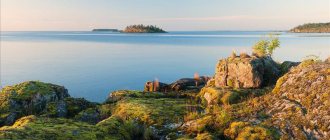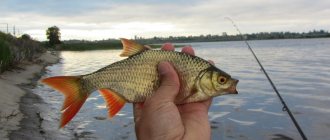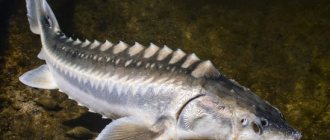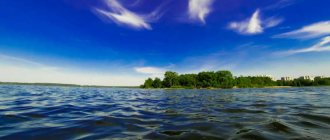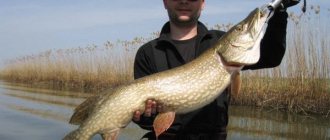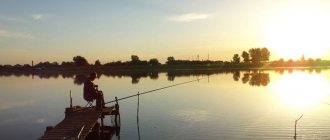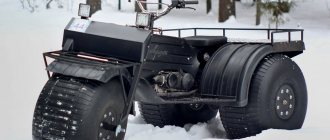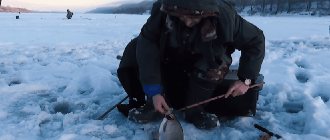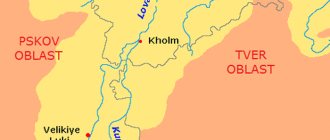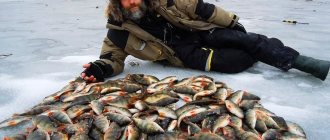Anyone who has ever gone summer or winter fishing in Karelia will forever remember this beautiful region with its unique nature. About 27 thousand small and large rivers and 60 thousand lakes of various sizes are rich in different types of fish, so fishing enthusiasts come here from different parts of Russia. For many of them, fishing has long become not a way of getting food, but a pleasure. Fish trolling in winter became a particularly exciting activity. Having been winter fishing in Karelia, you forget about the time and kilometers that you have to run from hole to hole in the hope of catching grayling, burbot or pike.
Features of fishing in winter
The winter fishing season opens in December, when lakes and rivers are covered with solid ice, and lasts until the end of April. In December, the ice is just setting, so there is still a lot of oxygen in the water and the fish in the reservoirs are quite active. At the beginning of the season, burbot can be easily caught with a spinner, and pike or pike perch can be caught with a winter bait. To catch smaller fish, use a regular fishing rod.
The thicker the ice becomes, the less light enters the water, and the amount of oxygen decreases. The fish becomes lethargic and inactive. Towards the end of January, there are practically no good catches, even among local fishermen who have extensive experience in winter fishing in Karelia. In order not to be left without fish during this period, you have to spend several hours on the ice, so for fishing it is better to choose large rivers and lakes, the water in which does not freeze so quickly. Despite the low activity of fish, in January pike are caught well on the girder, and with the use of complementary foods you can catch minnows or bream. February is considered the coldest month, so the bite practically stops, but those who are not afraid to freeze and are persistent have the opportunity to catch perch, ruffe or roach after preliminary feeding of the fishing spot.
What to do in Karelia in winter?
Karelia offers almost more entertainment in winter than in summer. Firstly, many attractions of Karelia are as accessible in winter as in summer. And secondly, in winter people come here for fresh frosty air, crisp snow and active recreation. Here are some ideas for winter holidays in Karelia , and what you can do here:
Visit Kizhi
Many people think that you can only sail to Kizhi Island in the summer. But this is not the case, and Kizhi is open to visitors all year round. And in winter it is especially beautiful and pleasant to walk here. You can get there by hovercraft or snowmobile.
Go skiing, alpine skiing and snowboarding
Although the mountains in Karelia are small, you can still go skiing here. The difference in elevation will be quite insignificant (maximum 100 meters), but there are usually no problems with snow here, which is why many are attracted to Karelia in winter.
There are several ski slopes in Karelia : Kallivo Park, Yalgora, Spasskaya Guba, Malaya Medvezhka, Gorka Center. And by the way! Don't forget about cross-country skiing. In winter, Karelia is a haven for them - after all, there is snow everywhere, and equipped trails and slopes are not needed at all. Near most camp sites and hotels there are excellent ski tracks.
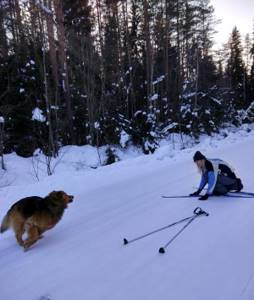
The car path near the camp site is great for skiing, Karelia
Look at the magical Ruskeala marble canyon
The Ruskeala Canyon is a famous Karelian attraction, which, however, is usually visited in the summer. And in vain! In winter, the marble canyon shines with its extraordinary lighting and looks like some kind of fairy-tale forest. It’s easy to get here all year round, and in winter there are fewer people - so it’s a great chance to have a great time and take beautiful photos.
Go on a snowmobile safari
Do you like active recreation and nature? Then you definitely need to try a snowmobile safari - after all, it is ideal for those who do not have a few free days for a long snowmobile tour, but who want to spend an active and varied holiday in Karelia in winter . There are many offers on the Internet of varying durations - tours from several hours to several days. This is a great opportunity to enjoy the amazing Karelian winter and get to places that cannot be reached by car or on foot.

On snowmobiles through the forests of Karelia
Go dog sledding
Typical entertainment for all northern countries, isn't it? Have you tried riding like this yourself? If not, then Karelia offers such an opportunity in winter. Here, by the way, it will cost less than in neighboring Finland. Tireless travelers can combine dog sledding and snowmobile tours. But it’s still better to plan these activities on different days, and of course dress warmly!
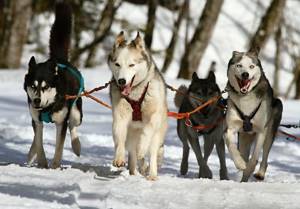
Karelia in winter: holiday in a snowy fairy tale 7
Get to the White Sea
If not everyone, then very many have been to the Black Sea, but the White Sea, and even in winter, is truly exotic. If you want to see the picturesque Russian north , then you should go to the White Sea. Here you can admire the beautiful scenery, go skiing, snowmobiling or go fishing. It is in the White Sea that the famous Solovetsky Islands are located, but in winter you can only get there by plane.
Ice fishing
For those who have never tried ice fishing, it is definitely worth going to it in Karelia in winter. And those who like ice fishing probably know that Karelia is one of the best places, because this region is very rich in fish and there are an incredible number of lakes. The winter fishing season in Karelia lasts from December to April, and then the ice becomes too thin.
To have fun for the whole group, and not just the fishermen, it’s worth going to some comfortable recreation center on Lake Onega, Lake Ladoga or the White Sea. So, everyone can find something to their liking.
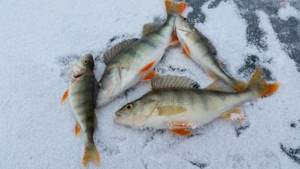
Typical for Karelia in winter
See the Northern Lights
The Northern Lights are a real wonder of the world that many people dream of seeing. But to do this, firstly, you need to go north, and secondly, ideal weather conditions must coincide. It is believed that it is in Karelia that such favorable conditions often develop in winter, and the chance of seeing the lights is high.
Indeed, it must be a frosty, clear night and the distance from large populated areas - otherwise, because of the city lights, you will not see anything (or only reflections). There are a lot of wild places in Karelia - or rather, the majority of them, so if you drive your own transport, you can easily catch the northern lights in some village at night. In addition, special tours , and experienced guides will take you to the “hot spots”. However, it is worth taking into account the weather conditions - here the guides will not be able to give you a 100% guarantee.
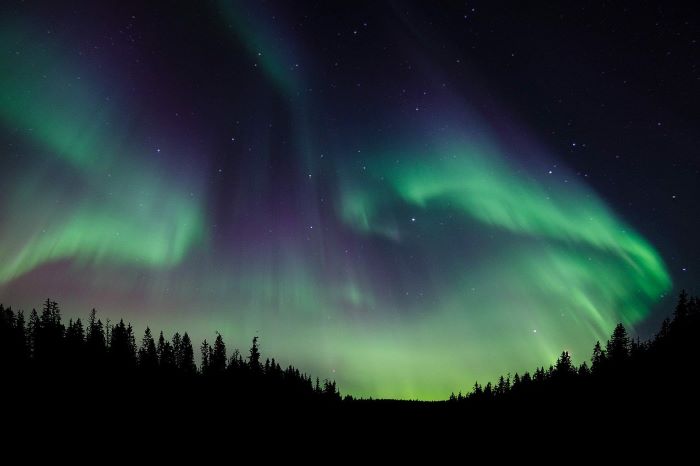
Karelia in winter: holiday in a snowy fairy tale 8
Tackle for winter fishing
For winter fishing in Karelia, different gear is used. They are not much different from those used by ice fishing enthusiasts in other regions of Russia. Local fishermen use homemade fishing rods or “Pierce” type donks. To catch predatory species (pike, pike perch), vertical trolling with balancers and spinners is used. For large fish, spinners are made independently by soldering additional hooks onto them; they also use hooks and girders. Smaller fish are caught using small purchased spoons (7-10 cm) and jigs with worms or maggots.
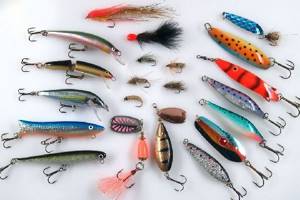
White fish are caught on winter rods with small nods and floats; for catching burbot, baits are used. At night, the gear is fixed in holes not far from each other and bait is made. Chicken giblets, pieces of meat or fish, and worms are used as bait. Larger fish are caught in lakes than in rivers, so experienced anglers recommend using thick fishing line 12-14 mm. Large fish (pike, pike-perch, perch) tear the thinner line.
Where is the best place to fish?
Many fishermen cannot decide where to go for winter fishing in Karelia. For lovers of comfort, travel agencies offer tours to the Sortavala, Pryazhinsky, Kondopoga and Pitkyaranta districts. They are more suitable for those who do not have sufficient ice fishing experience. A group of fishermen is provided with snowmobiles, drills and necessary gear, and an instructor is assigned to show the most fishing spots.
Experienced fishermen prefer to go wild with friends in order to fully enjoy winter fishing. It is better to get to remote places in the Kalevala or Louhi regions by private car, stopping overnight at bases. It is better to live in fishing huts in the Suoyarvi, Medvezhyegorsky or Muezersky districts. You can rent a snowmobile at the base, but you need to take care of the gear in advance.
Fishing on the rivers
There are large rivers in Karelia, but most of them are shallow and not very wide rivulets and streams. The banks and bottom there are often rocky, with a large number of snags and impenetrable thickets along the banks. Fish prefer to live in small, quiet pools and pools, so fishermen need to look for just such places.
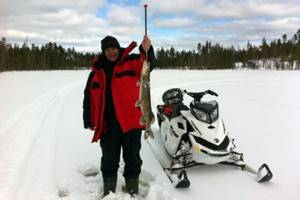
The most suitable for winter fishing in Karelia are the Suna, Shuya, Keret, and Pistajoki rivers. The rivers are inhabited by pike, roach, dace, ruffe, burbot, whitefish, and grayling. During the spawning season, salmon, pink salmon, whitefish and brown trout enter the riverbeds. Predatory breeds bite better in cloudy weather or during light snowfall.
Fish biting forecast on the Onega River
| Weather forecast and fish bite | Calendar, from 02/16/2021 to 02/19/2021 | |||||||||||
| VT | SR | Thu | PT | |||||||||
| Times of Day | Evening | Night | Morning | Day | Evening | Night | Morning | Day | Evening | Night | Morning | Day |
| Cloudiness, precipitation | Mainly cloudy | Partly cloudy | Clear | Partly cloudy | Clear | Clear | Partly cloudy | Mainly cloudy | light snow | Mainly cloudy | Partly cloudy | Clear |
| Temperature °C | -26 | -32 | -34 | -33 | -26 | -29 | -27 | -25 | -21 | -25 | -29 | -29 |
| Pressure, mm. | 765 | 767 | 768 | 768 | 768 | 768 | 767 | 764 | 763 | 765 | 767 | 768 |
| Direction, | North wind | North wind | North wind | North wind | Wind southwest | Wind southwest | Wind southwest | South wind | South wind | Wind southeast | East wind | Wind northeast |
| wind speed | 3 m/s | 2 m/s | 2 m/s | 1 m/s | 1 m/s | 2 m/s | 3 m/s | 4 m/s | 3 m/s | 2 m/s | 1 m/s | 1 m/s |
| According to the forecast, the fish will bite on: live bait (jigs), winter spinners, balancers Pike | 50% | 0% | 45% | 45% | 50% | 10% | 60% | 75% | 65% | 10% | 45% | 45% |
| According to the forecast, they will bite on: bloodworms, winter spoons, balance beams Perch | 40% | 0% | 55% | 55% | 60% | 0% | 70% | 65% | 55% | 0% | 55% | 55% |
| According to the forecast, they will bite on: bloodworms, maggots, bark beetles, burdocks Dace | 25% | 30% | 45% | 45% | 50% | 45% | 60% | 50% | 40% | 20% | 45% | 45% |
| According to the forecast, they will bite on: bloodworms, maggots, bark beetles, burdocks Ruff | 25% | 30% | 45% | 40% | 50% | 45% | 60% | 45% | 40% | 20% | 45% | 40% |
| According to the forecast, the fish will bite on: bloodworms, spoons, balance beams Trout | 20% | 0% | 50% | 35% | 50% | 0% | 70% | 45% | 40% | 0% | 50% | 35% |
| According to the forecast, they will bite on: bloodworms, oparish, spinners Grayling | 20% | 0% | 50% | 35% | 50% | 0% | 70% | 45% | 40% | 0% | 50% | 35% |
| Bait: maggot, bloodworm Bream | 20% | 45% | 40% | 30% | 50% | 65% | 60% | 40% | 40% | 35% | 40% | 30% |
| Bait: worm, live bait, spinner Burbot | 60% | 50% | 40% | 10% | 60% | 70% | 60% | 50% | 80% | 70% | 40% | 10% |
| Bait: maggot, bloodworm Roach | 40% | 0% | 55% | 45% | 50% | 0% | 70% | 65% | 55% | 0% | 55% | 45% |
| Bait: maggot, bloodworm Bleak | 30% | 0% | 50% | 50% | 50% | 0% | 60% | 50% | 40% | 0% | 50% | 50% |
| Bait: maggot, bloodworm, bark beetle Ide | 10% | 0% | 30% | 20% | 40% | 0% | 50% | 30% | 30% | 0% | 30% | 20% |
Fishing on the lakes
There are many lakes in Karelia, but not all of them get a good catch in winter. The most popular among winter fishing enthusiasts is Lake Ladoga. Its waters are home to more than 53 species of fish. Among the trophies of fishermen are burbot, Ladoga slingshot, rudd, pike, perch, salmon, bream, catfish, smelt and other species. In addition to them, you can catch Atlantic sturgeon and Volkhov whitefish, listed in the Red Book.

In second place in popularity is Vodlozero. Winter fishing in Karelia on Vodlozero lasts from November to May. It is located in the Pudozh region of Karelia. The lake stretches from north to south; on its water surface there are 196 islands, which are occupied by fishermen in summer and winter. The reservoir is home to more than 20 species of fish; the most common species are pike perch, bream, ide, vendace, roach, burbot, and perch.
What is winter like in Karelia?
There are a lot of reservoirs in Karelia, so the humidity here is high . What does it mean? The fact that the usual cold of -10℃ sometimes feels like -20℃. Of course, in any case, it depends on what you compare it to. For residents of southern Russia, winter here will seem frosty, but for those who come from Yakutia, Karelia in winter will seem like flowers to them.

Fairytale forests of Karelia
In any case, you need to go to Karelia in winter prepared and take good clothes with you. You will need not only warm shoes and outerwear, but also waterproof and windproof ones. There may suddenly be wet snow or strong winds. So if you are wet, then the rest will no longer be enjoyable.
Winter in Karelia is very beautiful, but daylight hours are short , so it is advisable to get up early, because visiting all attractions should end by 4 o'clock. But then you can enjoy barbecues and gatherings by the fireplace, or play snowballs or sledding in a lighted place.
Stories and advice from fishermen
Winter fishing in Karelia, according to the stories of experienced fishermen, will be successful if you choose the right place for it. Anyone who finds themselves on an unfamiliar lake is advised to start searching for fish by examining the immediate surroundings. Local fishermen, unlike visitors, come fishing alone, sometimes in twos or threes. Therefore, those who come to fish should focus on them, and not on those who spend time in a noisy company. Local fishermen visit reservoirs several times a week and know where and when the fish bite best.
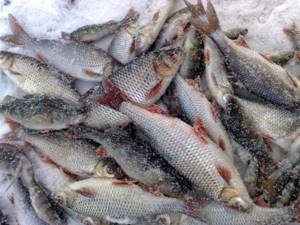
Many of them come to the ice at lunchtime or in the late afternoon, take certain places and leave the ice after a couple of hours. By focusing on their actions, you can get a good catch. Experienced fishermen first check the old holes and only then begin to drill new ones. After they find a fishing spot and stop, you can move in their direction without getting too close and drilling in several places. In one of them you will definitely find a school of fish.
Bases and guest houses for fishermen
Many fishermen from different parts of Russia are attracted to winter fishing in Karelia. The bases where you can stay for a long time are well equipped and located close to the places where the fish bite best. The best are considered:
- hotel-club "Gardarika" is located on the shore of Lake Yanisjärvi near the village of Vyartsilya;
- the Ladoga Skerries base is located on Lake Ladoga near the village of Tiurula, guests are offered small cozy houses for accommodation;
- the Niska base is located on the shores of Pyaozero near the village of Zasheyek, where fishing is most attractive from February to early May;
- “Karelian Zaimka” - the base is located near the village of Ostrov, fishermen live in houses of different price categories.
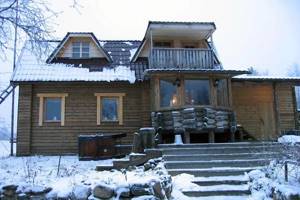
In addition to bases, guest houses have been built in many estates. Whole families often come to Karelia for winter fishing. And what could be better than hours spent with your loved ones enjoying a shared hobby?
Where to go
It all depends on a person’s personal preferences. If a fisherman does not want to move away from civilization, he should go to Lake Ladoga. It is the largest freshwater body of water in Europe, 219 km long and 125 km wide. The depth reaches 230 m. It is better to fish from a boat near the islands. Shore fishing is less effective. Large specimens are found in Ladoga. Along the shores of the lake there are several dozen recreation centers where you can stay overnight. Despite the developed infrastructure along the reservoir, it is not recommended to move far from populated areas, because The Karelian part of Ladoga is dense forests where it is easy to get lost.
Syamozero is also rich in islands, near which various species of fish are found. People come here to try their luck in fishing for pike perch and pike with a spinning rod. Before a trip to Syamozero, it is better to purchase several sets of spare spinners, because... The bottom topography of the reservoir is complex. The lake is shallow, so shore fishing here is no more effective than on Ladoga.
Read: Coho salmon fishing in Kamchatka
The Shuya River is famous not only for its fast flow, but also for its abundance of fish stocks. You can catch a trophy here using the simplest gear. The proximity of populated areas along the entire length of the riverbed allows easy access to the reservoir. In addition to fish, there are crayfish here, which indicates the purity of the water.
Masheozero is located 28 km from the capital of Karelia, Petrozavodsk. A convenient coastline provides the opportunity to use various fishing techniques. The species stock is poor: perch, roach, and pike. Fishermen value the reservoir for its transport accessibility.
Svyatozero can be reached from Petrozavodsk by car in 2 hours. People come here for bream and roach. If a sculpin is caught on a hook, it must be released; the fish is listed in the Red Book.
Konchozero is located 47 km from the regional capital. 20 species of fish live here. They stay at great depths closer to the middle of the reservoir. Fishing from the shore will not be effective here. The inhabitants of the lake are sensitive to weather. There is no bite on stormy and hot days.
Palyeozero is located in the Kondopoga region of Karelia. This is a large reservoir where bream, pike perch, roach and perch are found. It is easy to get here by private transport. There are roads on both sides of the lake. Fishing from the shore is fraught with loss of gear due to shallow depths and shallows.
Segozero is located 250 km from Petrozavodsk. Despite difficult transport accessibility, the reservoir is widely popular among fishermen. People come here for burbot, grayling and pike. There are practically no settlements along the shore of the reservoir. When going to this place, a person should count on complete autonomy of the trip.
Read: Catching American palya in the Leningrad region
